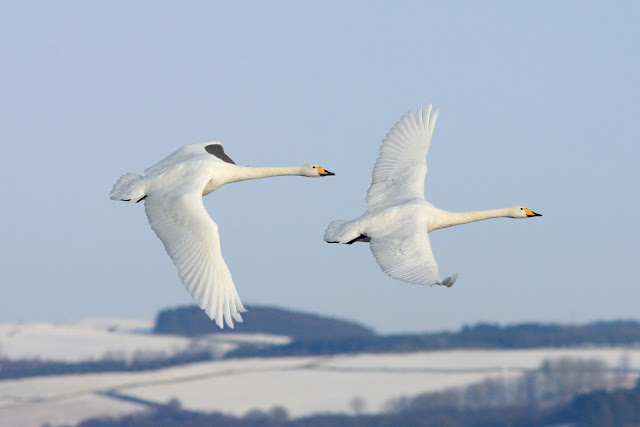From the Real Iceland
 |
| Two Whooper Swans in flight |
 |
| A Whooper Swan tries to keep warm in winter |
 |
| A young Whooper Swan gliding to land |
Some
500 Whooper Swans come to the Solway area near to Caerlaverock with
around 300 taking up winter residence on the reserve. It is always exciting to
see parents arriving with new offspring, for the same birds tend to return each
year. However it is a sad occasion when a bird known to have left Iceland
remains unaccounted for. Once here, they are sometimes seen alongside our
resident Mute Swans but, with their distinctive yellow and black bills emitting
frequent ‘whooping’ noises, they are easy to distinguish.
Each winter at WWT Caerlaverock the reserve wardens and scientists catch large numbers of Whooper Swans to enable them to further their research and understanding of these birds. The swans are weighed, measured, have blood samples taken to check for viruses and toxins, and ringed.
 |
| A Whooper Swan on an icy pond |
With
international law now protecting Whooper Swans it would be reasonable to assume
that the birds should reach their normal lifespan of 10 – 12 years without
facing significant danger. Sadly, this is not the case; lead shot is still a
major problem. Although banned in the UK it is permitted in Iceland. Shot from
spent gun cartridges or fishing is swallowed by the birds and just 3 pellets
will cause a prolonged and painful death. Despite international protection a staggering 14% of
Whooper Swans have lead pellets embedded in their bodies as a consequence
of being shot. However, despite all of the hazards the swan population is
actually healthy and growing steadily to the extent that WWT no longer regard
Whooper Swans to be a conservation concern.
Long may the current optimism continue for these wonderfully vocal birds are part of the Solway scene and somehow winter would never be the same without them.
 |
| Three Whooper Swans in flight |
If you would like to receive an automatic notification whenever I post anything new please go to the top right corner of the white main page and enter your email address in the box below 'Follow by Email' and then click on 'submit'. Please follow the instructions carefully and you will be notified by e-mail whenever I add to this blog.
You
can also register as a 'follower' on the right hand side of this page
by clicking on the 'join this site' link below the 'followers' badge.
However you need to complete the 'Follow by Email' as above to receive
automatic update notifications.
Thank you for visiting my blog. Your support is important to me and much appreciated.
Follow me at:- www.tomlanglandsphotography.com
Follow me at:- www.facebook.com/TomLanglandsPhotography
Follow me at:- www.facebook.com/TomLanglandsPhotography
Follow me at:- www.tomlphotography.blogspot.com
Follow me at:- www.twitter.com/tomlphotography
Follow me at:- www.flickr.com/photos/tom_langlands_photography
Articles and photography copyright of Tom Langlands



Gorgeous and informative article Tom...thank you:)
ReplyDeleteHolding tight to my dreams!
Love this post! My husband and I have always wanted to travel to Iceland. Here in the south east corner of Minnesota we are fortunate to witness the migration of Tundra swans every year. We're looking forward to a day trip soon when we can go photograph them.
ReplyDeleteBest,
Melissa
www.ChinDeep.com (Melissa Placzek Photography)
More great images, Tom! You really do capture excellent flight shots. I would love to have the opportunity to capture birds like this. Looking forward to your next post and your photos on your Facebook page.
ReplyDeleteLiz,
ReplyDeleteThank you for your visit to my blog and for leaving a comment. I'm glad that you enjoyed it. I see also that you have listed yourself as a follower - that is much appreciated too. If you want to be sure of receiving an email notification when I post something new just add your details to the 'follow by email' window in the top right corner of my blog page. That way I make sure that you are automatically updated whenever I post anything new. Im just mentioning this and am not putting you under any pressure to do it.
I must put something new up very soon - watch this space.
Thanks again for your kind comments
Tom